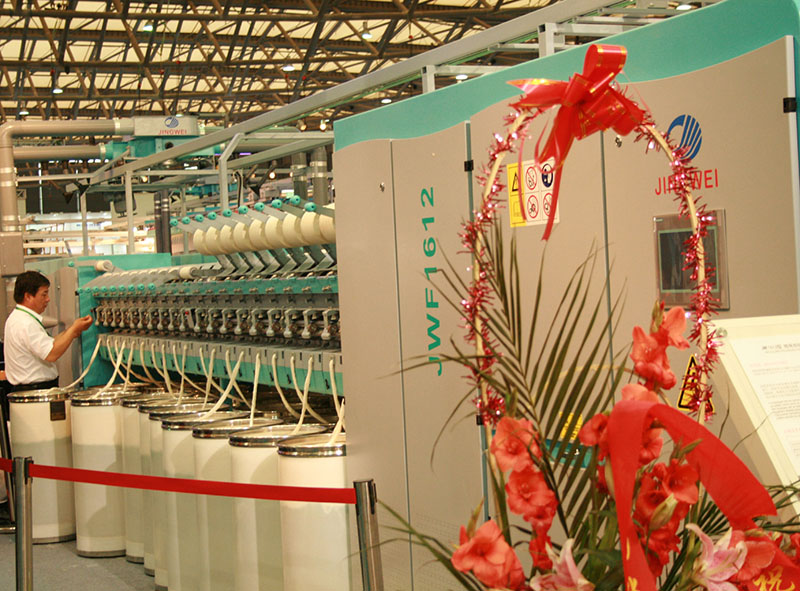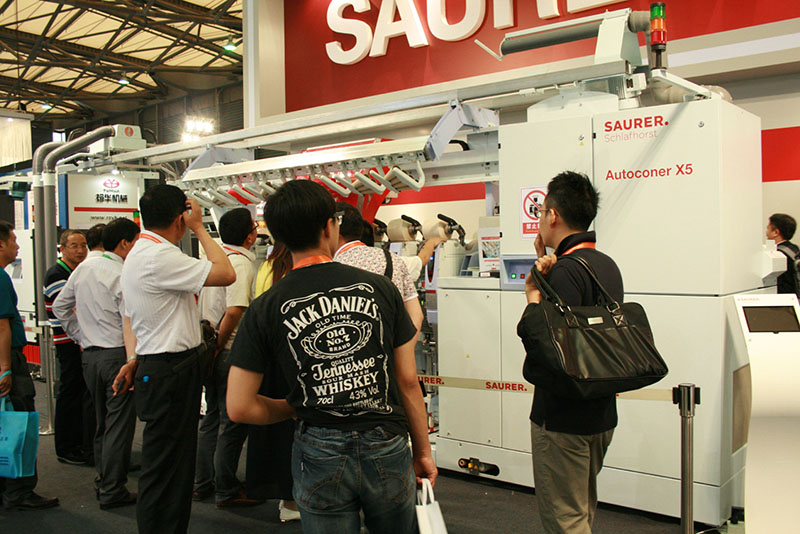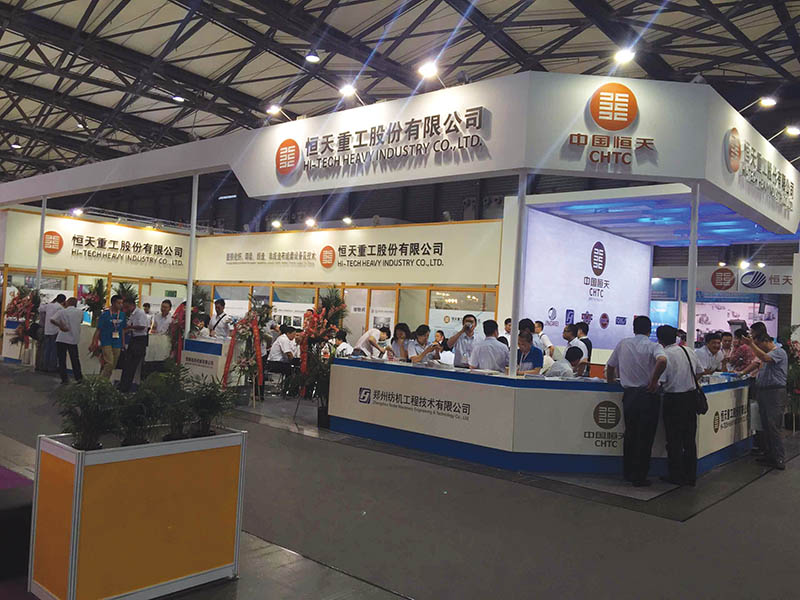The emphasis at ITMA Asia + CITME 2016 will be on advanced automation, clean production and resource efficiency
Around 100,000 visitors from around the world are expected to visit the ITMA Asia + CITME 2016 textile machinery show, which takes place from October 21-25 at the new National Exhibition and Convention Centre (NECC) in Shanghai, China.
“The combined show is now well-entrenched in the textile machinery exhibition calendar,” said Maria Avery, secretary general of the event organizer Cematex. “It draws all the leading textile and garment manufacturers and is an essential showcase for the Asian market, offering plenty of business and networking opportunities.”
Around 1,600 exhibitors from 27 countries will take part, including all of the major brands for fiber and yarn spinning machinery and related technology.
Chinese leader
Dominating the show once again will be China Hi-Tech Group Corporation (CHTC) the major Chinese fiber and textile machinery manufacturer, which consists of over 200 subsidiary and branch companies employing more than 54,000 people.
CHTC includes the former Oerlikon carding machinery business now known as Autefa, following its takeover in 2011; the huge Fong’s Group, also acquired in 2011; and Monforts, the German finishing machine specialist, which has been owned by the group since 2012.
CHTC’s Chairman Zhang Jie has recently alluded to considerable progress in his organization’s adoption of Industry 4.0.
“Increased automation and digital control will be accelerated across all of our machines ranges and this is only the first step,” he said. “In the future, we anticipate the further full integration with both suppliers and customers, because completely integrated supply chains are the future.”
For some time CHTC’s focus has understandably been on synchronization of all of its operations and restructuring, in addition to extending levels of service. The company has, however, also recently installed its first intelligent spinning factory in China, which can be fully controlled by mobile phone from anywhere in the world, so it will be interesting to see what further CHTC developments are unveiled in Shanghai.

Sustainability
Many European companies will be taking the opportunity to demonstrate the machines they introduced at the ITMA 2015 in Milan for the first time in Asia.
ITMA 2015 was certainly a solid success for the Italian textile machinery builders represented by the trade association ACIMIT, which celebrated its 70th anniversary last year. A total of 453 Italian companies occupied 32,540 square meters of space in Milan – 30% of the total and an increase of over 50% compared to the last ITMA in Barcelona in 2011.
The ITMA 2015 theme, “Master the Art of Sustainable Innovation” will be equally as relevant in Shanghai, especially given China’s current commitments to resource efficiency and clean production.
Competitive
“The textile machinery sector is moving towards more competitive production processes,” observed ACIMIT President Raffaella Carabelli. “Reduced production costs, through savings in the consumption of water, energy and raw materials are being combined with greater attention to environmental issues.”
Her sentiments are shared by Regina Brückner, chair of the textile machinery branch of Germany’s VDMA and managing associate of finishing machinery leader Brückner: “Sustainability in terms of machinery and production is about thinking in the long term and considering the total life cycle of that machine and what savings and efficiencies can be made.”
“Volatile prices and sporadic shortages for energy as well as commodities and stricter environmental legislation are putting textile producers in Asia under pressure to adjust,” added Nicolai Strauch, responsible for overseas markets at the VDMA. “In a range of studies, our member companies have proved that investment in the latest German technology increases profits through higher energy efficiency.”
Fiber options
Germany’s Oerlikon Neumag will emphasize its extensive plant portfolio for the production of synthetic staple fibers at the Shanghai show.
This includes the following options:
- Daily production of between five to 3,000 tons.
- One or two-step technologies.
- Polypropylene, polyester, recycled polyester, polyamide or alternative fiber systems for commodity or special applications.
The company’s compact Staple Force S 1000 has been specifically designed for the economic production of staple fibers in small batch sizes of up to 15 tons per day, requiring low initial investment and with a compact construction.
By replacing the conventional steam and water baths with a dry drawing process over godets, energy costs can be considerably reduced. The technology combines the spinning and subsequent drawing in one process, making it possible to produce up to 80 tons of staple fibers each day. The process is ideally suited to recycled polyester, whether chip or flake.
A major competitive advantage of the 300-tons per day staple fiber plant for commodity fibers, however, is the considerably higher profitability per ton compared to smaller plants, as a result of their energy efficiency. It is also possible to color the fibers while spinning. In side stream extrusion, the master batch can be mixed directly into the spinning process. Bicomponents are also possible, including sheath/core, side-by-side, islands-in-the-sea or trilobal types.

Yarn spinning
Swiss-headquartered, Chinese-owned Saurer is meanwhile involved in the supply of yarn spinning equipment for a very significant amount of the global production of apparel.
Saurer’s current focus is on its E3 program – shorthand for economy, energy and ergonomics. The emphasis is on energy saving, efficient and waste-minimizing production, with maximized productivity per square meter in the mill, along with improved handling. Double-digit savings in energy are being achieved with many of the latest Saurer machines. Automation and smart sensor technology are very much at the heart of these improvements.
With 4,000 employees worldwide and annual sales of around €1 billion, Saurer can draw on over 160 years of experience in improving production processes at different stages of the textile value chain, with a leading position in many areas of textile technology.
Labor shortages
“We have to constantly adapt our products in order to match our understanding of major trends,” said Saurer CEO Martin Folini. “Currently, these include skilled labor shortages in key markets, most notably in China, as well as resource efficiency – particularly in respect of energy usage – and the quick turnaround demanded by the fast fashion market.”
At present, the rising cost of personnel and a shortage of skilled labor is a major problem in China.
“Young people no longer want to go into the textile industry so there’s a need to make our machines as highly automated and simple to operate as possible,” said Folini. “User-friendly interfaces, reduced set-up times and self-cleaning and regulating systems have been our response.”
Strategic promotion
“ITMA ASIA + CITME is the leading marketing platform for textile machinery manufacturers seeking to tap the China market,” said Charles Beauduin, president of Cematex. “We are pleased to provide them with a recognized platform for their strategic promotion and will ensure that the combined show continues to be a relevant and an effective platform for sellers and buyers to transact business and to take advantage of the vast potential that China offers.”
As China continues to expand its infrastructure construction sector, accelerate urbanization and increase awareness of environmental protection under the government’s 13th Five-Year Plan period (2016-2020), it is expected that demand for technical textiles and nonwovens products in particular will rise in the coming years.
“As China’s textile industry continues its transformation, the demand for advanced machinery and technology is on the rise,” said Gu Ping, vice president of the China Textile Machinery Association (CTMA), adding, “For textile manufacturers to keep ahead of the industry, they need to readjust their strategy to enhance overall production efficiency. They should adopt a longer-term outlook to focus on the quality of their products, which will ultimately contribute to their company’s bottom line. This will lead to a demand for new machinery and technology to modernize and upgrade existing textile equipment.”


